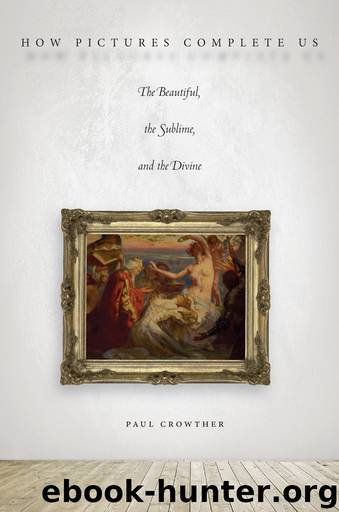How Pictures Complete Us by Paul Crowther

Author:Paul Crowther [Crowther, Paul]
Language: eng
Format: epub
Publisher: Stanford University Press
Published: 2016-03-14T04:00:00+00:00
FIGURE 16. Mark Rothko, Light Red over Black, 1957. © 1998 Kate Rothko Prizel and Christopher Rothko / Artists Rights Society (ARS), New York / IVARO, Dublin (2015).
In effect, the work involves space-occupying forms that declare becoming-visible. While things become visible all the time, we are generally preoccupied with our day-to-day practical interests to notice this emergence. Any place in which we are presently situated, for example, changes its visual appearance in accordance with the available light sources and the specific character of how they illuminate surfaces and spaces. But if we are washing the dishes or attending to a computer screen or the like, we never think of how things become visible—we have no time for considering such broader meanings. This means, in other words, that everyday life does not favor consideration of how becoming-visible is basic to our experience of space-occupancy. Such becoming is no more than an unnoticed aspect of transperceptual space. Light Red over Black, in contrast, draws attention to becoming-visible and in so doing also exemplifies one of the most important aspects of Rothko’s mature oeuvre in general.
It is worth dwelling a little more on how this becoming-visible is achieved. The band structure of Light Red over Black emphasizes the horizontal dimension of space-occupancy—perhaps better described as the “horizonal aspect.” For while the human body is oriented toward the vertical through its posture, the limits of its immediate operations are marked out by the perceptual horizon and the substance of things as spatially extended. Our created spatial environment is dominated by square and rectangular shapes, on the basis of which we fabricate dwelling places and other structures. In Rothko’s work, there is a kind of merging of the human spirit with the basic spatial structures of the horizonal in which it lives. The suggestion of spirit is achieved through the aforementioned uneven densities of paint and fraying effects, as well as through the suggestion of veiled luminosity within the bands and fields—a light suggestive of something living and actively working through the human level of space-occupancy.
Now, while the structures just described are basic to Rothko’s mature work, he varied them in a number of important site-specific commissions, most notably for the purpose-built chapel in Houston that now bears his name. We shall consider a different set of works, however. In 1958, Rothko received a commission to paint a series of pictures to be hung in the Four Seasons restaurant in the Seagram Building in New York, a commission that caused him many problems but also led him to explore alternative pictorial formats.12 Even though he withdrew from the commission, he was able to complete three series of works based on it; and between 1968 and 1969 he gave nine pictures (taken, apparently, from the second and third of these series) to the Tate Gallery in London.13 We shall proceed to discuss a group of them.
The group consists of five works each titled Black on Maroon (four of them from 1958 and one from 1959) and four works each with the title Red on Maroon (painted in 1959).
Download
This site does not store any files on its server. We only index and link to content provided by other sites. Please contact the content providers to delete copyright contents if any and email us, we'll remove relevant links or contents immediately.
The Secret History by Donna Tartt(18225)
Red Sparrow by Jason Matthews(5204)
Harry Potter 02 & The Chamber Of Secrets (Illustrated) by J.K. Rowling(3559)
In a Sunburned Country by Bill Bryson(3376)
Drawing Cutting Edge Anatomy by Christopher Hart(3301)
Figure Drawing for Artists by Steve Huston(3277)
Harry Potter and the Prisoner of Azkaban (Book 3) by J. K. Rowling(3125)
The Daily Stoic by Holiday Ryan & Hanselman Stephen(3116)
Japanese Design by Patricia J. Graham(3006)
The Roots of Romanticism (Second Edition) by Berlin Isaiah Hardy Henry Gray John(2825)
Make Comics Like the Pros by Greg Pak(2763)
Stacked Decks by The Rotenberg Collection(2699)
Harry Potter and the Deathly Hallows (7) by J.K. Rowling(2554)
Draw-A-Saurus by James Silvani(2514)
Tattoo Art by Doralba Picerno(2497)
On Photography by Susan Sontag(2494)
Foreign Devils on the Silk Road: The Search for the Lost Treasures of Central Asia by Peter Hopkirk(2389)
Churchill by Paul Johnson(2374)
The Daily Stoic by Ryan Holiday & Stephen Hanselman(2353)
